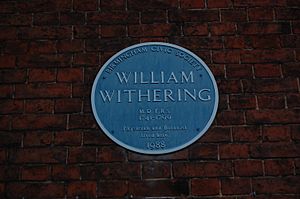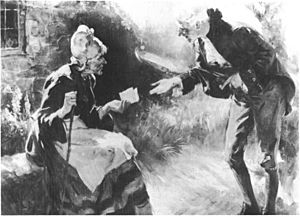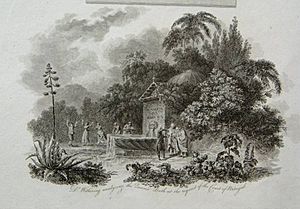William Withering facts for kids
Quick facts for kids
William Withering FRS
|
|
|---|---|
 |
|
| Born | 17 March 1741 Wellington, Shropshire, England
|
| Died | 6 October 1799 (aged 58) Sparkbrook, Birmingham, England
|
| Nationality | English |
| Citizenship | Great Britain |
| Known for | Discovery of digitalis |
| Scientific career | |
| Fields | Botanist, geologist, chemist, physician |
| Academic advisors | William Cullen |
| Signature | |
 |
|
William Withering (born March 17, 1741 – died October 6, 1799) was a very smart English scientist. He was a botanist (someone who studies plants), a geologist (someone who studies rocks and Earth), a chemist (someone who studies chemicals), and a physician (a doctor). He is most famous for being the first person to carefully study how a plant called foxglove could be used as medicine.
Withering was born in Wellington, England. His father was a surgeon. William studied medicine at the University of Edinburgh Medical School to become a doctor. Later, he worked at Birmingham General Hospital. A famous story says he saw a person with "dropsy" get much better after taking a traditional plant-based medicine. Dropsy is when your body swells up, often because of heart problems. Withering realized the helpful part of the medicine came from the foxglove plant. The active ingredient is now called digoxin, named after the plant. In 1785, Withering wrote an important book called An Account of the Foxglove and some of its Medical Uses. This book shared his findings and how to use foxglove safely.
Contents
William Withering's Life Story
William Withering studied medicine in Edinburgh, Scotland, from 1762 to 1766. In 1767, he started working as a doctor in Stafford. He married Helena Cookes in 1772. She was an artist who drew plants. They had three children.
In 1775, William became a doctor at Birmingham General Hospital. He later became ill with a lung problem called pulmonary tuberculosis. He traveled to Portugal twice, hoping the warmer weather would help him feel better. On his way home from his second trip, his ship was chased by pirates!
In 1785, he became a member of the important Royal Society, which is a group for top scientists. That same year, he published his famous book about foxglove. The next year, he rented a large house called Edgbaston Hall in Birmingham. He was also part of a group called the Lunar Society. This was a club for smart thinkers and scientists who met during full moons.
In 1791, there were riots in Birmingham. William got ready to leave his home, but his staff kept the rioters away until soldiers arrived. In 1799, he bought a new house called "The Larches" because Edgbaston Hall was too cold. He moved there on September 28 and sadly passed away on October 6, 1799.
William Withering's Plant Studies
In 1776, William Withering published a very important book called The botanical arrangement of all the vegetables naturally growing in Great Britain. This book was one of the first in English to use the new system for classifying plants. This system was created by a Swedish scientist named Carl Linnaeus.
Some people criticized Withering because he left out some details about how plants reproduce. He explained that he wanted his book to be easy for everyone to read, especially women. At that time, botany (the study of plants) was becoming a popular subject for women. His wife, Helena, was a talented artist who drew many of the plants he collected.
Withering published two more editions of his plant book. After he died, his son continued to publish it. The book was used as a standard guide for British plants for almost 100 years! William also studied fungi (like mushrooms) and invented a small, folding microscope. This microscope was perfect for taking with him on trips to study plants outdoors. He also helped popularize tools like the plant press and the vasculum (a special container for collecting plants).
In 1787, he became a member of the Linnean Society, another important science group. A plant called Witheringia solanacea was even named after him! Because of his great work, people in Europe called him "The English Linnaeus." Today, there is a special teaching position at the University of Birmingham Medical School named the William Withering Chair in Medicine. They also have an annual lecture in his honor.
How William Withering Discovered Digitalis
William Withering learned about using foxglove to treat "dropsy" (swelling) from a folk healer in Shropshire. This healer used a mix of over 20 different plants. Withering figured out that the foxglove plant was the key ingredient that helped people.
For nine years, he carefully tested different parts of the foxglove plant. He tried collecting them at different times of the year. He wrote down details from 156 cases where he used foxglove. He described how it worked and the safest way to use it.
Another famous doctor, Erasmus Darwin, also became interested in foxglove. In 1785, Darwin presented a paper about using foxglove. However, Withering's book, which had many more detailed cases, was published around the same time. This led to some disagreements between the two doctors.
You might hear a story about Withering learning about foxglove from an old woman named "Mother Hutton." However, this story is not true! "Mother Hutton" was actually created in 1928 for an advertisement. Withering himself never mentioned meeting an old woman directly. He wrote that a colleague asked him to look at a secret family recipe from an old woman.
Withering's own writings show that he was already interested in foxglove before this. He had suggested in his 1776 plant book that foxglove should be studied more. So, his deep knowledge of plants helped him realize the importance of foxglove.
William Withering's Work in Chemistry and Geology
William Withering was also very interested in chemistry and geology. He did many experiments on a heavy rock called Terra Ponderosa from England. He realized it contained a new element that no one had described before. Later, scientists found out it was barium carbonate. In 1789, a German geologist named Abraham Gottlob Werner named the mineral Witherite in Withering's honor.
Withering also tested the minerals in different spa waters, both in England and other countries. He famously analyzed the water at a healing spa in Caldas da Rainha, Portugal. Because of this work, he was chosen to be a member of the Royal Academy of Sciences of Portugal.
Remembering William Withering
William Withering was buried on October 10, 1799, at Edgbaston Old Church in Birmingham. We don't know the exact spot of his grave. However, a special memorial stone inside the church has carvings of foxgloves and the Witheringia solanaceae plant. These carvings celebrate his discovery and his important work in botany.
He is also remembered by one of the Lunar Society Moonstones in Birmingham. These stones mark places connected to the Lunar Society. There is also a blue plaque at Edgbaston Hall, which tells people he lived there. The University of Birmingham School of Medicine has a special teaching position named after him.
In 2011, a restaurant and pub called J D Wetherspoon opened in Wellington, where Withering was born. It was named after him to honor his memory.
William Withering's Publications

Here are some of the books and papers William Withering wrote:
- 1766 Dissertation on angina gangrenosa (a medical paper)
- 1773 "Experiments on different kinds of Marle found in Staffordshire" (about types of soil)
- 1779 "An account of the scarlet fever and sore throat, or scarlatina; particularly as it appeared at Birmingham in the year 1778" (about a disease)
- 1782 "An analysis of two mineral substance, vz. the Rowley rag-stone and the toad stone" (about rocks)
- 1783 "Outlines of mineralogy" (a translation of another book about minerals)
- 1784 "Experiments and observations on the terra ponderosa" (about the heavy rock he studied)
- 1785 "An account of the foxglove and some of its medical uses; with practical remarks on the dropsy, and some other diseases" (his most famous book about foxglove)
- 1787 "A botanical arrangement of British plants..." (the second edition of his plant book)
- 1788 Letter to Joseph Priestley on the principle of acidity, the decomposition of water. (a letter about chemistry)
- 1790 "An account of some extraordinary effects of lightning" (about lightning)
- 1793 "An account of the scarlet fever and sore throat..." (the second edition of his disease book)
- 1793 "A chemical analysis of waters at Caldas" (about the water in Caldas, Portugal)
- 1794 "A new method for preserving fungi, ascertained by chymical experiments" (about how to keep fungi)
- 1795 "Analyse chimica da aqua das Caldas da Rainha" (a chemical analysis of the water of Caldas da Rainha, in Portuguese)
- 1796 "Observations on the pneumatic medicine" (about air-based medicine)
- 1796 "An arrangement of British plants..." (the third edition of his plant book)
- 1799 "An account of a convenient method of inhaling the vapour of volatile substances" (about breathing in vapors)
Images for kids






